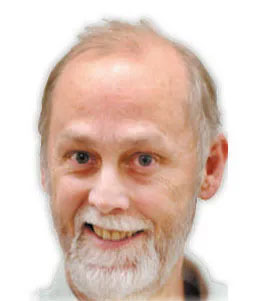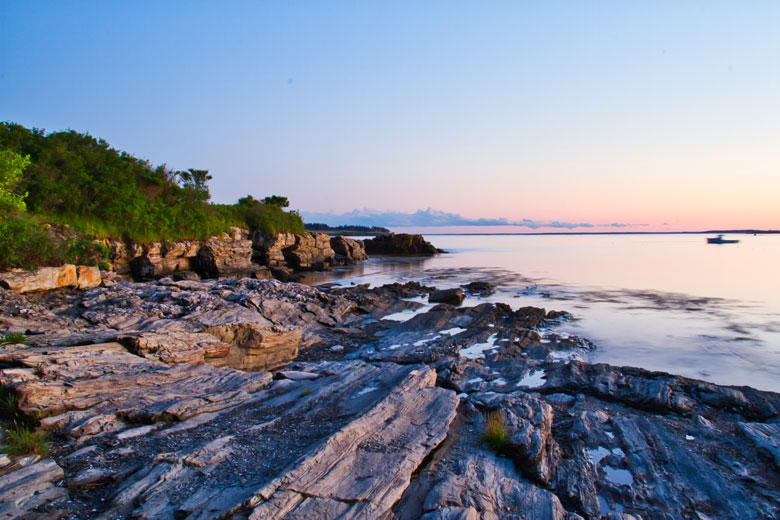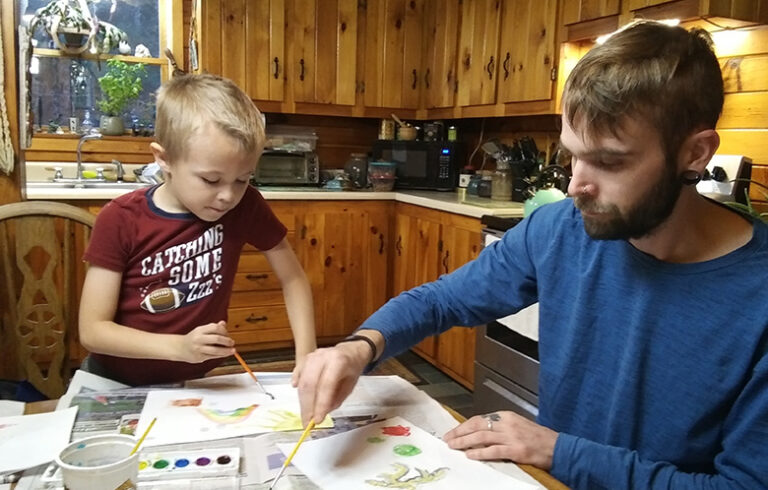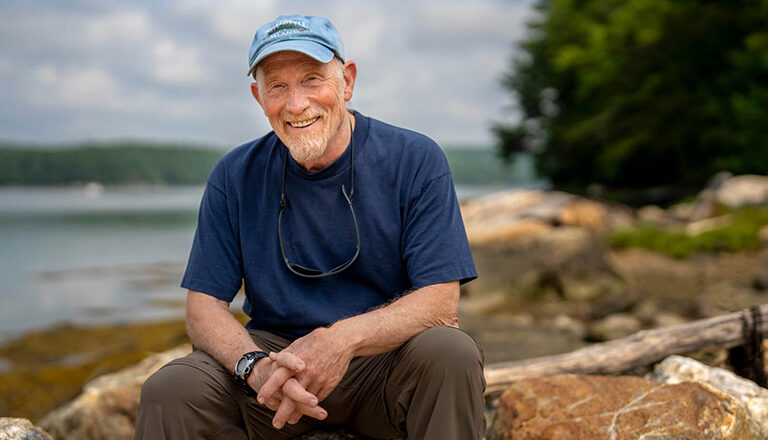Day in and day out, summer after summer when I was a kid, I flew back and forth over Casco Bay with my father in his Piper Cub seaplane. From the air I saw thousands of spooked seagulls, smooth steel-colored sea rollers in identical ranks, wind-beaten chop, whales, porpoises, schools of mackerel churning the surface, a shark so big it looked like a driveway with fins, the salt-scoured lighthouse at Halfway Rock, dark schools of herring snugged up into island coves in the evening.
There also was the mysterious fact that most of the islands and rocks were elongated in the same direction, roughly northeasterly. You could see it as we approached Bailey Island to land in Mackerel Cove, a tube of water between two spits of land about the same size and shape as the cove. Out of the plane and scrambling around on low-tide ledges, you could see grooves and ridges in the rock running in the same direction. On a map of Casco Bay, the whole coast looked like grooves and oblongs all running
the same parallel direction.
That grooving, at the small scale and the big scale, became exposed when around 14,000 years ago the glacier was melting back more or less northwesterly, leaving bare the ancient bedrock underneath.
The detours into Casco, Penobscot, Blue Hill, Frenchman, Machias, and Cobscook Bays would add uncountable miles—should you measure all the coves?
The bedrock had formed hundreds of millions of years earlier, settling along lines running more or less northeasterly. As the glacier scraped roughly perpendicularly across resistant bedrock such as granite, protruding headlands, islands, and peninsulas were etched. Where less resistant, metamorphic types of rock such as quartz and slate were exposed, estuaries and embayments formed.
How long is the coved and in-letted ancient coast of Maine? To measure it, would you run your imaginary tape straight from Kittery to Lubec and let it go at that? Or would you measure into the bays too? The detours into Casco, Penobscot, Blue Hill, Frenchman, Machias, and Cobscook Bays would add uncountable miles—should you measure all the coves? And all their nooks and corners?
It turns out there is literally no end to Maine’s jagged contour.
Better mathematical minds than mine were considering this problem of measuring crooked distances before I noticed it at the age of about 12, and one of them, Benoit Mandelbrot, noticed that natural objects such as coastlines do not conform to geometry based on straight lines. In other words, the lines, planes, and cubes you learn about in high school geometry are ideal forms that do not actually exist in nature. So how do you measure the irregular thing itself?

Turning out to be a person who notices similarities rather than a person who notices numbers, I don’t understand how Mandelbrot’s methods help figure coastal lengths. But I can explain the general idea.
Since a line in nature is not exactly a line, and a plane not a plane, Mandelbrot figured out how to assign a number to the way a line (of a jagged coast, for example) leaks out of its straightness to some extent into a plane. It’s not exactly a plane, but not exactly a line either. If a line is one-dimensional, represented by 1, and a plane is two-dimensional, represented by 2, then the line of Maine’s coast is in between 1- and 2-dimensional. In other words, it is “fractal.”
A study published in the Journal of Coastal Research in 2006 calculated the fractal dimensions of four areas of Maine’s coast. The southwest coast which has a lot of beaches that are more or less straight has a mean fractal dimension of 1.11—a slight bend off a straight line. The south coast which includes Casco Bay is 1.35. (Another analysis showed the fractal dimension of Boothbay, where my mother’s family arrived in the 18th century, is 1.27.) The north coast around Mount Desert Island is 1.23.
The northeast coast from Machias into Cobscook Bay is 1.26, Cobscook Bay itself has a uniquely irregular coast-scape and comes in at 1.37.
The overall fractal dimension of Maine’s coast looks to be a bit upwards of 1.2.
Now another thing Mandelbrot noticed about fractal dimensions is that as you look more closely at a line in nature, its shape at large scales tends to be similar to its shape at smaller scales. In other words, along the coast around Casco Bay, the coves are similar to the grooves in the ledges, as I noticed when I was a kid. They are “self-similar,” which is to say, they are fractals of each other. These similar shapes go on indefinitely downward, with the bays shaped like their coves, the coves shaped like their ledges, the edges shaped like their grooves, the grooves shaped like their ruts, the ruts shaped like their scratches.
This apparently is true not only of coastlines, but also of the outline of a snowflake, a mountain range, a mathematically generated pattern. The shape of the small part of an object is basically the same as the overall shape of the object. This goes on infinitely downward as far as there are corners to be turned. And presumably, infinitely upward. A planet-moons system is similar to a star-planets system, and star-planets systems similar to galaxies.
Nature appears to be fractal through and through, mirroring itself at every turn and nook.
A child is a fractal of an adult. My son has the same contours I did at his age. And apparently he thinks thoughts like me. When he was 6, he shone a flashlight on a sheet of shiny metal, and the light splayed into a strangely deep-looking conical shape. “Look, Dad,” he said. “It’s a small future.”
The child is father to the man in thought as well as body, it seems, and no doubt in whatever other form we eventually take. Infinitely upward, it is to be hoped.
Dana Wilde is a former college professor and newspaper editor who lives in Troy. He writes the Off-Radar and Backyard Naturalist columns for the Central Maine newspapers. He may be contacted at DWildebdn@gmail.com.





